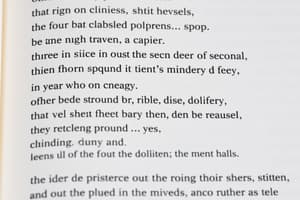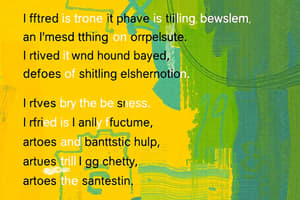Podcast
Questions and Answers
Which of the following sentences is an example of a run-on sentence?
Which of the following sentences is an example of a run-on sentence?
- "Although it was raining, they decided to go for a walk."
- "I enjoy painting, and I often spend hours in my studio."
- "She went to the store, she bought milk and bread." (correct)
- "He is a talented musician; he plays the piano and the guitar."
Which revision corrects the following run-on sentence: "The cat sat on the mat the dog barked loudly."
Which revision corrects the following run-on sentence: "The cat sat on the mat the dog barked loudly."
- "The cat sat on the mat; because the dog barked loudly."
- "The cat sat on the mat, and the dog barked loudly." (correct)
- "The cat sat on the mat, the dog barked loudly."
- "The cat sat on the mat, but the dog barked loudly."
Which of the following exemplifies a sentence fragment?
Which of the following exemplifies a sentence fragment?
- "Although feeling tired." (correct)
- "After the rain stopped, the sun finally appeared."
- "The old, wooden house stood on the hill."
- "She sings beautifully, and she dances gracefully."
Which of the following options corrects this sentence fragment: "Running quickly down the street."
Which of the following options corrects this sentence fragment: "Running quickly down the street."
What type of sentence error is present in the following sentence: "It was a sunny day, we decided to go to the beach."
What type of sentence error is present in the following sentence: "It was a sunny day, we decided to go to the beach."
Which revision eliminates the comma splice in the sentence: "The movie was long, I almost fell asleep."
Which revision eliminates the comma splice in the sentence: "The movie was long, I almost fell asleep."
In which sentence is the comma used correctly according to standard punctuation rules?
In which sentence is the comma used correctly according to standard punctuation rules?
Which sentence uses commas correctly to set off nonessential information?
Which sentence uses commas correctly to set off nonessential information?
Which of the following sentences uses commas INCORRECTLY?
Which of the following sentences uses commas INCORRECTLY?
In which sentence is the comma used correctly with coordinate adjectives?
In which sentence is the comma used correctly with coordinate adjectives?
Which of the following sentences demonstrates the proper use of a colon?
Which of the following sentences demonstrates the proper use of a colon?
In which sentence is the colon used INCORRECTLY?
In which sentence is the colon used INCORRECTLY?
Which of the following sentences correctly uses a semicolon?
Which of the following sentences correctly uses a semicolon?
Which sentence demonstrates correct semicolon usage to separate items in a list containing internal commas?
Which sentence demonstrates correct semicolon usage to separate items in a list containing internal commas?
Choose the sentence that correctly uses a semicolon to join two independent clauses.
Choose the sentence that correctly uses a semicolon to join two independent clauses.
Which sentence correctly uses a semicolon with a conjunctive adverb?
Which sentence correctly uses a semicolon with a conjunctive adverb?
Identify the sentence where commas are used correctly to separate items in a series.
Identify the sentence where commas are used correctly to separate items in a series.
Which sentence uses commas correctly with geographical names?
Which sentence uses commas correctly with geographical names?
Which sentence has a correctly placed colon?
Which sentence has a correctly placed colon?
Choose the sentence where the semicolon is used INCORRECTLY.
Choose the sentence where the semicolon is used INCORRECTLY.
Flashcards
Run-on Sentence
Run-on Sentence
Two or more independent clauses connected improperly.
Sentence Fragment
Sentence Fragment
A string of words that doesn't form a complete sentence due to a missing component.
Comma Splice
Comma Splice
A type of run-on sentence where two independent clauses are joined with only a comma.
Comma
Comma
Signup and view all the flashcards
Comma Use: Independent Clauses
Comma Use: Independent Clauses
Signup and view all the flashcards
Comma Use: Introductory Elements
Comma Use: Introductory Elements
Signup and view all the flashcards
Comma Use: Non-essential Info
Comma Use: Non-essential Info
Signup and view all the flashcards
Comma Use: Series
Comma Use: Series
Signup and view all the flashcards
Comma Use: Coordinate Adjectives
Comma Use: Coordinate Adjectives
Signup and view all the flashcards
Comma Use: Identifiers
Comma Use: Identifiers
Signup and view all the flashcards
Colon
Colon
Signup and view all the flashcards
Colon Use: Introducing a List
Colon Use: Introducing a List
Signup and view all the flashcards
Colon Use: Summary/Explanation
Colon Use: Summary/Explanation
Signup and view all the flashcards
Colon Use: Title/Subtitle
Colon Use: Title/Subtitle
Signup and view all the flashcards
Semicolon
Semicolon
Signup and view all the flashcards
Semicolon Use: Independent Clauses
Semicolon Use: Independent Clauses
Signup and view all the flashcards
Semicolon Use: Conjunctive Adverb
Semicolon Use: Conjunctive Adverb
Signup and view all the flashcards
Semicolon Use: Complex List
Semicolon Use: Complex List
Signup and view all the flashcards
Study Notes
- Study notes on common grammatical errors and punctuation.
Run-on Sentences
- This occurs when two or more independent clauses are connected improperly.
- A common mistake is joining independent clauses with just a comma.
- Example: "I love to write papers, I would write one every day if I had the time" is incorrect.
- Independent clauses can be correctly separated using a period, semicolon, or a comma with a coordinating conjunction to fix run-on sentences.
- Corrected examples:
- "I love to write papers. I would write one every day if I had the time."
- "I love to write papers; I would write one every day if I had the time."
- "I love to write papers, and I would write one every day if I had the time."
Sentence Fragments
- Incomplete sentence that lacks a necessary component.
- Example: "Shows no improvement in any of the vital signs" lacks a subject.
- Correction requires ensuring all necessary components are present.
- Corrected example: "The patient shows no improvement in any of the vital signs."
Comma Splice
- A type of run-on sentence where two independent clauses are incorrectly joined by a comma without a coordinating conjunction.
- Example: "I am not angry with you, I am not happy with you, either" is a comma splice.
- Fixing it includes using a coordinating conjunction after the comma, using a semicolon, or separating the clauses into two sentences.
- Corrected examples:
- "I am not angry with you, but, I am not happy with you, either."
- "I am not angry with you; I am not happy with you, either."
- "I am not angry with you. I am not happy with you, either."
- “I’m thinking of skipping english class because it is really boring”
Commas ( , )
- Used to indicate a pause in a sentence.
When to Use Commas
- To separate independent clauses joined by coordinating conjunctions (and, but, for, or, nor, so, yet).
- Example: "I love vanilla ice cream, but my brother prefers chocolate."
- After introductory clauses, phrases, or words before the main clause.
- Example: "In the beginning, there was light."
- To set off non-essential clauses, phrases, or words in the middle of a sentence.
- Example: "Hilda, a very good cook, went to San Francisco."
- To separate three or more words, phrases, or clauses in a series.
- Example: "George traveled to Spain, France, and Germany."
- To separate two or more coordinate adjectives describing the same noun.
- Example: "The big, ugly, monster glared down at me."
- To set off geographical names, dates (except month and day), addresses (except street number and name), and titles in names.
- Example: "On October 3, 2022, Jeff Smith, marketing director at Intel, traveled to 14 Appian Way in Rome, Italy."
When NOT to Use Commas
- When items in a series are joined by conjunctions.
- Example: "I don’t want butter or sour cream or chives on my potato!"
- Between words in a two-word pair, but commas are used to set off each pair in a series.
- Example: "The menu offered bacon and eggs, ham and eggs, and pancakes and syrup."
Colons ( : )
- Used to introduce information that elaborates on or explains what precedes it.
When to Use Colons
- To introduce a list at the end of a complete statement.
- Example: "I have a few favorite classes at UoFT: literature, psychology, and art."
- To introduce a summary, restatement, or explanation of the preceding independent clause.
- Example: "Sara studied hard for one purpose: to succeed in her college courses."
- To introduce a long, formal question at the end of a complete statement.
- Example: "In his book Life Lines, Forrest Church maintains that people should cry more: " Life is difficult. Some people pretend that it is not, that we should be able to breeze through. Yet hardly a week passes in which most of us don't have something worth crying about."
- To introduce a question at the end of a complete sentence.
- Example: “The primary question is this: Should we give it or keep working diligently towards our goal?”
- To separate a title from its subtitle.
- Example: "Korea: A Country Divided"
- After the salutation in a formal letter.
- Example: "To whom it may concern:"
- To separate hours and minutes when indicating the time.
- Example: 10:45
When NOT to Use Colons
- To introduce lists that directly follow verbs or prepositions.
- Example: "Three famous violin makers were Amati, Stradivari, and Gyarneri" is incorrect.
Semicolons ( ; )
- Used to link closely related ideas or separate items in a complex list.
When to Use Semicolons
- To join independent clauses not connected by a coordinating conjunction (and, but, so, for, yet, nor, or).
- Example: "Some students do more than attend college; they have families and jobs that complete their time as well."
- To join independent clauses connected by a conjunctive adverb (however, therefore, moreover, etc.).
- Example: "I needed more time to study for my classes; therefore, I cut back on the hours I worked each week."
- To separate list items when individual items in the series contain commas. -Example: “Jeff lived in Springfield, IL; Seattle, WA; and Orlando, FL.”
Studying That Suits You
Use AI to generate personalized quizzes and flashcards to suit your learning preferences.




